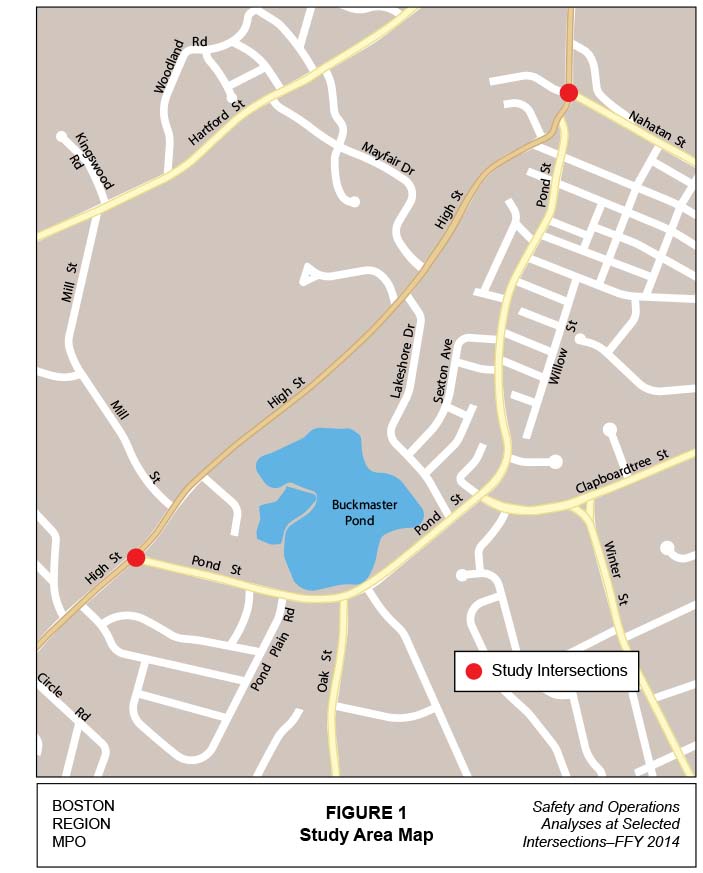
Technical Memorandum
DATE: May 21, 2015
TO: Jeffrey Bina, Town Engineer, Westwood
FROM: Seth Asante, MPO Staff
RE: Safety and Operations Analyses—Westwood
Selected Intersections: High Street at Nahatan Street and High Street at Pond Street in Westwood
This memorandum summarizes the analyses and improvement strategies for two intersections: High Street at Nahatan Street and High Street at Pond Street in Westwood. The opening sections give a background of the study and describe the existing conditions and problems that concern the community. Following that is an assessment of the safety and operations problems and a discussion of the potential improvement strategies. The final section of the memo presents the study recommendations. The memorandum also includes technical appendices that cite the methods used and data applied in the study, including detailed reports of the intersection capacity analyses.
In November 2013, the Town of Westwood submitted a list of intersections with safety and congestion issues to the Metropolitan Planning Organization (MPO) (Appendix A1). The town wanted the MPO to consider these intersections when selecting various sites for Unified Planning Work Program (UPWP) studies, such as Safety and Operations Analyses at Selected Intersections—Federal Fiscal Year (FFY) 2014. In addition, the Town of Westwood expressed its intention to cooperate with and support the MPO in this planning study, and to implement the recommended improvements where appropriate, and based on the town’s ability to fund them. The two intersections discussed here were chosen from the list for study under the Safety and Operations Analyses at Selected Intersections program.
The purpose of the Safety and Operations Analyses at Selected Intersections program is to identify problems at intersections in the region’s arterial highways that experience many crashes, congestion, or mobility issues for buses, bicyclists, and pedestrians and develop multimodal solutions to address the problems identified. The MPO has been conducting these planning studies for the past ten years, and municipalities in the region are very receptive to them. The studies give towns the opportunity to look at the requirements of a specific location, starting at the conceptual level, before they commit funds for design and engineering. Moreover, if the project qualifies for federal funds, the study’s documentation eventually would be useful to the Massachusetts Department of Transportation (MassDOT) as well.
Following a selection process,2 four locations from a short list of 21 intersections were approved for study by the Boston Region MPO based on a series of criteria including, high crash rate, number of pedestrian and bicycle crashes, transit significance3, regional significance4, and implementation potential5. The four locations approved for study are:
The two Westwood locations were selected because of their safety and congestion problems (Figure 1).
An advisory task force composed of representatives from Westwood was established to participate in this study. MPO staff met with the task force two times: 1) to discuss the work scope and finalize existing conditions and problems, and 2) to present improvement concepts for comment. Working in conjunction with the task force, MPO staff collected data and conducted analyses to identify and quantify existing problems and their proposed improvement strategies. Both the task force and MassDOT Highway Division District 6 staff reviewed the study documents (Appendix A).

Route 109 is a predominantly two-lane, two-way arterial roadway that passes through eight communities from east to west: Dedham, Westwood, Dover, Walpole, Medfield, Millis, Medway, and Milford. Although Route 109 is a state-numbered route, it is locally controlled. The roadway is part of the National Highway System (NHS) program and is eligible for federal funds provided for the program. It is functionally classified as a principal arterial. In Westwood, the local name for Route 109 is High Street (henceforth, used throughout the memorandum). High Street—near the Nahatan Street intersection between Pond Street and Saint Margaret Mary Church—has 10- to 15-foot wide landscaped-curbed median and two 11-foot wide travel lanes in each direction (Figure 2). There are five- to six-foot continuous and connected sidewalks on both sides. The posted speed limit is 30 miles per hour (mph) on the segment of High Street near Nahatan Street, and 35 mph on the segment near Pond Street (close to the Sheehan School). The right-of-way is approximately 80 feet wide near the intersection of High Street with Nahatan Street.
Nahatan Street is a town-owned roadway functionally classified as an urban minor arterial. It is a two-lane, two-way roadway running in a north-south direction, generally with 11-foot wide travel lanes. A five-foot-wide continuous and connected sidewalk with a grass buffer is provided on the west side of Nahatan Street. The sidewalk on the east side of Nahatan Street has gaps; however, crosswalks have been provided at the breakpoints to connect to the sidewalk on the west side for continuity. The right-of-way generally varies between 40 and 50 feet but widens significantly to about 180 feet at the approach to High Street because of the presence of a median, traffic islands, and turn lanes to channel traffic through the intersection (Figure 2). The posted speed limit is 30 mph in both directions, although it is reduced to 20 mph when the Thurston Middle School is in session.
Pond Street is a town-owned roadway, functionally classified as an urban collector. Pond Street is a two-lane, two-way loop that intersects High Street at two locations: 1) about 200 feet west of Nahatan Street, and 2) about 1.1 miles west of Nahatan Street near the Sheehan School. Both intersections were included in this study. The right-of-way is approximately 50 feet wide and the land use is zoned residential.
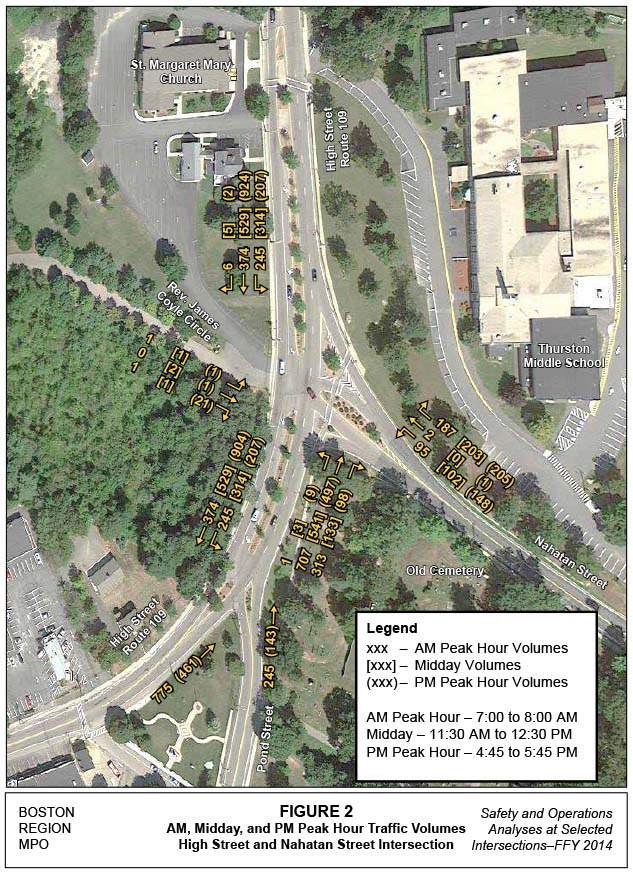
There is a five-foot continuous sidewalk with a grass buffer on one side of Pond Street. There are sidewalks on both sides of Pond Street near High Street, close to the Sheehan School.
The Reverend James W. Coyle Circle is a two-way driveway and access roadway, providing entry to Westwood New Cemetery and the Saint Margaret Mary Church. The roadway is not functionally classified and generally is used when there is a church or funeral activity.
High Street, Nahatan Street, and Reverend James W. Coyle Circle form a four-legged two-way stop-sign-controlled intersection (Figure 2). The primary traffic flow through the intersection is along High Street. The intersection has multi-lane approaches because of high traffic volume during peak periods. The High Street eastbound approach widens to two lanes approximately 200 feet prior to the intersection and continues as two lanes through the intersection until approximately 300 feet past the intersection, where it merges into a single lane. The High Street westbound approach widens into two travel lanes approximately 250 feet prior to the intersection; the left approach lane is marked for left turns to Nahatan Street. The Nahatan Street northbound approach widens to accommodate two lanes: 1) a shared left/through lane controlled with a stop sign, and 2) an exclusive right-turn lane controlled with a yield sign.
The intersection has traffic islands and medians that channel traffic through the intersection and provide refuge for pedestrians crossing Nahatan Street. Sidewalks are present along all corners of the intersection, but only one crosswalk is provided at the intersection—for crossing Nahatan Street. The existing curb ramps do not meet ADA requirements—they lack detectable warning plates. The land use near the intersection is zoned residential. The Thurston Middle School is located in the northeast corner, the Saint Margaret Mary Church in northwest corner, and the Old Westwood Cemetery in the southeast corner of the intersection. Approximately 200 feet west of the Nahatan Street intersection is Pond Street, which intersects High Street to form a three-legged unsignalized intersection. Because of its close proximity, the Pond Street intersection was evaluated as part of analyzing the Nahatan Street intersection.

Pond Street and High Street form a three-legged unsignalized intersection (Figure 3). The primary traffic flow through the intersection is along High Street. The High Street eastbound approach widens to accommodate a free right turn onto Pond Street; but, the westbound approach is a single-lane approach. Traffic on Pond Street is controlled with a stop sign and drivers form two lanes at the approach during peak periods—one for turning left and one for turning right—because its approach is approximately 30 feet wide. The geometry of the intersection results in a long crosswalk on Pond Street. Curb ramps are present at the intersection but they lack detectable warning plates and do not meet ADA requirements.
Traffic volume data were collected to assess operational characteristics of the intersections. MPO staff collected turning-movement counts (TMC) at the intersections in April 2014, when schools were in session (Appendix B). The counts were conducted during weekday morning, midday, and evening peak travel periods. All TMCs were conducted from 7:00 to 9:00 AM, 11:00 AM to 2:00 PM, and 3:00 to 6:00 PM. Heavy vehicles, including school buses, and trucks, were counted separately. Pedestrian and bicycle counts were conducted simultaneously with the TMCs.
Based on the counts, the average weekday traffic volume on High Street was approximately 20,200 vehicles per day (VPD) east of Nahatan Street; 9,300 VPD on Nahatan Street near High Street; and 7,400 VPD on Pond Street near the Sheehan School. Figures 2 and 3 show the turning movement volumes at the intersections. At both intersections, the primary High Street traffic flow (peak direction) is eastbound during the AM peak period and westbound on during the PM peak period. In addition, there are high-volume traffic interchanges between High Street and Nahatan Street, and between High Street and Pond Street (near the Sheehan School). The percentage of heavy vehicles observed at the intersections during the AM and PM peak periods, ranged between 3.0% and 5.5%. These rates are not considered particularly high for peak-period traffic conditions. In addition, staff did not detect any roadway geometry—such as turning radii, which would inhibit truck or bus traffic flow.
Table 1 presents the number of pedestrians and bicyclists observed at the two intersections during the eight-hour period when the TMCs were conducted. Students at the Thurston Middle School and neighborhood residents accounted for the majority of pedestrians observed at the intersection of High Street and Nahatan Street. At the High Street and Pond Street intersection, the majority of pedestrians were residents of that neighborhood.
TABLE 1
Number of Pedestrians and Bicyclists at the Study Intersections
Intersection |
Pedestrian Count |
Bicyclist Count |
High Street at Nahatan Street |
111 |
30 |
High Street at Pond Street (near Sheehan School) |
23 |
23 |
Source: Central Transportation Planning Staff.
A summary of the crashes in terms of severity, manner of collision, ambient light, road surface, and weather conditions—based on 2009-2013 crash reports from the Westwood Police Department—is presented in Table 2. Records show 38 crashes at the High Street and Nahatan Street intersection during the five-year period. At the intersection of High Street and Pond Street (near the Sheehan School), records show nine crashes during the same period. The prevalent types of crashes at both intersections were rear-end and angle collisions. Records show one pedestrian crash at the crosswalk in front of the Saint Margaret Mary Church near the High Street and Nahatan Street intersection.
Staff calculated intersection crash rates per the MassDOT Highway Division methodology, for the entire five-year period. The most recent statewide average crash rate for unsignalized intersections—based on MassDOT crash information queried on January 23, 2013—is 0.60 crashes per million entering vehicles (MEV). For MassDOT Highway Division District 6 (which includes the Town of Westwood), the average crash rate is 0.58 per MEV for unsignalized intersections. Analyses indicate that the average crash rate of 0.92 MEV for the High Street and Nahatan Street intersection exceeds the District 6 average crash rate for unsignalized intersections. The average crash rate of 0.26 MEV for the High Street and Pond Street intersection was below the District 6 average crash rate for unsignalized intersections. See Appendix C for crash rate work sheets.
MPO staff used police crash reports to prepare collision diagrams, which are useful for examining patterns and developing safety strategies (see Figures 4 and 5 below). The numbers in the collision diagram uniquely identify each crash and, for more detail about the crash, may be used to cross reference the crash records provided in Appendix C.
TABLE 2
Crash Summary (2009-2013)
Crash Variable |
High Street and Nahatan Street and Pond Street Intersection |
High Street and Pond Street Intersection (near Sheehan School) |
Crash Severity |
-- |
-- |
Non-fatal injury |
9 |
0 |
Property damage only |
29 |
9 |
Manner of Collision |
-- |
-- |
Angle |
9 |
8 |
Rear-end |
16 |
0 |
Sideswipe, same direction |
7 |
0 |
Single vehicle crash |
6 |
1 |
Road Surface Condition |
-- |
-- |
Dry |
27 |
8 |
Wet |
8 |
1 |
Snow |
3 |
0 |
Ambient Light Conditions |
-- |
-- |
Daylight |
27 |
7 |
Dark – lighted roadway |
11 |
2 |
Weather Conditions |
-- |
-- |
Clear |
25 |
5 |
Cloudy |
4 |
3 |
Rain |
6 |
1 |
Snow |
3 |
0 |
Travel Period |
-- |
-- |
Peak-period |
13 |
5 |
Off-peak |
25 |
4 |
Total crashes |
38 |
9 |
Five-year average (rounded) |
8 |
2 |
Average crash rate |
0.92 |
0.26 |
MassDOT Highway Division District 6 Crash Rate for unsignalized intersection |
0.58 |
0.58 |
* The AM peak period is 7:00 AM to 9:00 AM, and the PM peak period is 4:00 PM to 6:00 PM.
Source: Central Transportation Planning Staff.
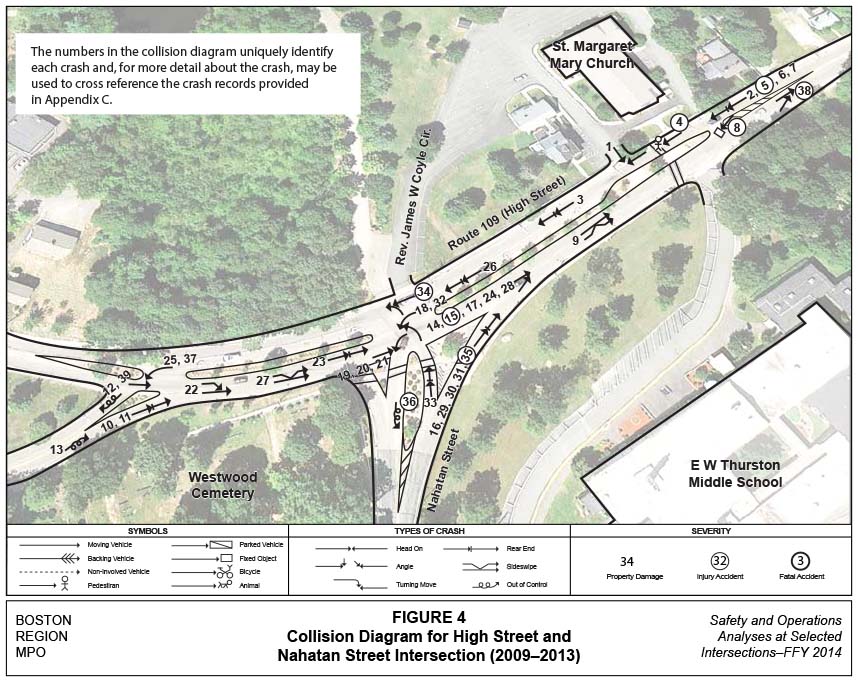

As seen in Figures 4 and 5 above, the prevalent crash patterns are:
Staff conducted traffic operations analyses consistent with the Highway Capacity Manual (HCM) methodologies (included in Appendix D)6. HCM methodology demonstrates driving conditions at signalized and unsignalized intersections in terms of level of service (LOS) ratings from A through F. LOS A represents the best operating conditions (little to no delay), while LOS F represents the worst operating conditions (very long delay). LOS E represents operating conditions at capacity (limit of acceptable delay). Table 3 presents the control delays associated with each LOS for unsignalized and signalized intersections. . Using the data collected, MPO staff built traffic analysis networks for the AM and PM peak hours with Synchro7 to assess the capacity and quality of traffic flow through the intersections.
TABLE 3
Intersection Levels of Service Criteria
Level of Service |
Signalized Intersections Control Delay |
Unsignalized Intersections Control Delay |
A |
0-10 |
0-10 |
B |
> 10-20 |
> 10-15 |
C |
> 20-35 |
> 15-25 |
D |
> 35-55 |
> 25-35 |
E |
> 55-80 |
> 35-50 |
F |
> 80 |
> 50 |
Source: Highway Capacity Manual 2010.
Results of the peak-hour intersection capacity analyses (Table 4) indicate that traffic volumes on High Street are so large that drivers on Nahatan Street do not get adequate gaps to enter the intersection during peak hours—left-turn movements from Nahatan Street onto High Street operate at LOS F during peak hours. Staff observed similar traffic operations problems the High Street and Pond Street intersection during peak periods. Drivers turning left from Pond Street onto High Street experience much delay and operate at LOS F during peak hours—the 95th-percentile queue length range is 12-to-16 car lengths.
TABLE 4
Existing (2014) Peak-Hour Level of Service
Intersection / Approach |
Move |
AM LOS |
AM Delay |
AM Queue* |
PM LOS |
PM Delay |
PM Queue |
High Street at Nahatan Street |
-- |
-- |
-- |
-- |
-- |
-- |
-- |
High St Eastbound |
L+T+R |
A |
0 |
0 |
A |
0 |
0 |
High St Westbound |
L |
B |
11.7 |
50 |
A |
9.4 |
25 |
High St Westbound |
T+R |
A |
0 |
0 |
A |
0 |
0 |
Rev. James Coyle Circle |
L+T+R |
D |
32.4 |
25 |
D |
30.6 |
25 |
Nahatan St Northbound |
L+T |
F |
97.5 |
150 |
F |
92.8 |
150 |
Nahatan St Northbound |
R |
B |
14.5 |
50 |
B |
11.1 |
25 |
High Street at Pond Street (near Nahatan Street) |
-- |
-- |
-- |
-- |
-- |
-- |
-- |
High St Eastbound |
T |
A |
0 |
0 |
A |
0 |
0 |
High St Westbound |
L |
B |
10.3 |
20 |
A |
9.6 |
50 |
High St Westbound |
T |
A |
0 |
0 |
A |
0 |
0 |
Pond St Northbound |
R |
E |
35.5 |
125 |
B |
13.5 |
50 |
High Street at Pond Street (near Sheehan School) |
-- |
-- |
-- |
-- |
-- |
-- |
-- |
High St Eastbound |
T+R |
A |
0 |
0 |
A |
0 |
0 |
High St Westbound |
L+T |
A |
0.6 |
0 |
A |
0.5 |
0 |
Pond St Northbound |
L |
F |
114.5 |
225 |
F |
152.9 |
350 |
Pond St Northbound |
T+R |
B |
14.4 |
25 |
A |
9.8 |
5 |
a Delay in seconds per vehicle. b 95th percentile queue length in feet. # = the 95th-percentile volume exceeds capacity.
Source: Central Transportation Planning Staff.
Traffic control signals are valuable devices for controlling vehicular and pedestrian traffic. They assign the right-of-way to various traffic movements and thereby strongly influence traffic flow. Traffic control signals that are properly designed, located, operated, and maintained will provide orderly movement of traffic, and reduce congestion and the frequency and severity of certain types of crashes, especially right-angle collisions. Traffic control signals are not solutions to all traffic problems at intersections. Poorly designed and maintained, ineffectively placed, improperly operated, or unjustified traffic control signals can result in excessive delays, significant increase in crashes (especially rear-end type), and diversion of traffic to less adequate routes, as road users attempt to avoid the traffic control signals. Investigating the need for a traffic control signal at an unsignalized intersection includes analyzing factors related to the existing operations and safety, as well as the potential to improve these conditions. Such an investigation is called traffic signal warrant analysis.
Using the methodology in the 2009 edition of Manual on Uniform Traffic and Control Devices8 (MUTCD), staff performed detailed traffic signal warrant analyses to determine whether installation of traffic control signals at the intersections is justified and if they would improve safety and traffic operations. The MUTCD lists nine traffic signal warrants that justify installing a traffic signal at a study location:
Table 5 presents the results of the signal warrant analysis; detailed traffic signal warrant analysis worksheets are included in Appendix D. Existing conditions at High Street and Nahatan Street satisfy five of the warrants. Existing conditions at
TABLE 5
Results of Traffic Signal Warrant Analysis
Warrant |
High Street and Nahatan Street Intersection |
High Street and Pond Street Intersection |
Warrant 1, Eight-Hour Vehicular Volume |
Satisfied |
Not satisfied |
Warrant 2, Four-Hour Vehicular Volume |
Satisfied |
Satisfied |
Warrant 3, Peak Hour |
Satisfied |
Satisfied |
Warrant 4, Pedestrian Volume |
Not satisfied |
Not satisfied |
Warrant 5, School Crossing |
Not satisfied |
Not satisfied |
Warrant 6, Coordinated Signal System |
Not satisfied |
Not satisfied |
Warrant 7, Crash Experience |
Satisfied |
Not satisfied |
Warrant 8, Roadway Network |
Satisfied |
Satisfied |
Warrant 9, Intersection Near a Grade Crossing |
Not satisfied |
Not satisfied |
Source: Central Transportation Planning Staff.
High Street and Pond Street satisfy three of the warrants. The MUTCD states that satisfying traffic signal warrants alone does not require installing a traffic control signal. The intersection of High Street and Pond Street did not satisfy the major warrants, Warrants 1 and 7. Warrant 1 is for locations with a large amount of intersecting traffic or where traffic on a major street is so heavy that, as a result, traffic on a minor intersecting street suffers excessive delay. Warrant 7 is for locations with frequent and severe crashes.
To forecast systematically future traffic volume based on changes in the transportation network or land use, planners generally employ a planning model. For this study, staff utilized the Boston Region MPO’s “regional travel demand model set” most recently adopted for its Long-Range Transportation Plan (LRTP). This model’s socioeconomic components are derived from forecasts produced by the Metropolitan Area Planning Council (MAPC). The model is calibrated at a regional level for 164 cities and towns, which includes all of the 101 cities and towns in the MPO region. For site-specific development and transportation projects, the model needs to be calibrated to replicate local travel patterns in the project area before it may be used to forecast the project’s future impacts. Using this model, staff projected that traffic on High Street would grow 0.3% per year, resulting in 3% total growth between 2014 and 2024.
MPO staff developed and analyzed short- and long-term improvements to address the problems. Staff used the projected growth factors from the regional model set to expand existing peak-hour turning-movement volumes, which were used to test the improvement strategies. The results are included in Appendix D.
The concerns at the intersections are:
Below are the improvement strategies that staff evaluated for the intersection:
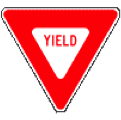
R1-2
Yield sign

R1-1
Stop sign
Source: MUTCD 2009 edition
The improvement would:
The improvement would not reduce traffic delays for Nahatan Street left-turn movements (Table 6).
The Federal Highway Administration9 estimates converting yield-sign control to stop-sign control could reduce related crashes between 9-and-29 percent. The cost of implementing these improvements, including signs and pavement markings, would cost less than $5,000.
MPO staff proposes that a pedestrian-activated flashing beacon be installed for the marked crossing on High Street in front of Saint Margaret Mary Church and Thurston Middle School to give advance warning to drivers or pedestrians
TABLE 6
High Street and Nahatan Street Intersection Future Year (2024)
Peak-Hour Level of Service
Improvement Alternative |
Move |
AM LOS |
AM Delaya |
AM Queueb |
PM LOS |
PM Delay |
PM Queue |
Alternative 1: Stop Control |
-- |
-- |
-- |
-- |
-- |
-- |
-- |
High St Eastbound |
L+T+R |
A |
0 |
0 |
A |
0 |
0 |
High St Westbound |
L |
B |
12.2 |
50 |
A |
9.6 |
25 |
High St Westbound |
T+R |
A |
0 |
0 |
A |
0 |
0 |
Rev. James Coyle Circle |
L+T+R |
E |
40.2 |
25 |
D |
32.6 |
25 |
Nahatan St Northbound |
L+T |
F |
123 |
175 |
F |
>180 |
300 |
Nahatan St Northbound |
R |
C |
15.1 |
50 |
B |
12.3 |
25 |
Total intersection |
All |
B |
11.2 |
-- |
E |
41.4 |
-- |
Alternative 3: Reconfigure Lanes and Tighten Curb Radius |
-- |
-- |
-- |
-- |
-- |
-- |
-- |
High St Eastbound |
L+T |
A |
0 |
0 |
A |
0 |
0 |
High St Eastbound |
R |
A |
0 |
0 |
A |
0 |
0 |
High St Westbound |
L |
B |
11.9 |
50 |
A |
9.8 |
25 |
High St Westbound |
T+R |
A |
0 |
0 |
A |
0 |
0 |
Rev. James Coyle Circle |
L+T+R |
E |
37.9 |
25 |
D |
34.9 |
25 |
Nahatan St Northbound |
L+T |
F |
106.1 |
125 |
F |
>180 |
300 |
Nahatan St Northbound |
R |
A |
0 |
75 |
A |
A |
0 |
Total Intersection |
All |
A |
7.7 |
-- |
E |
46.1 |
-- |
Alternative 4: Tighten Approach Curb Radius for Nahatan Street |
-- |
-- |
-- |
-- |
-- |
-- |
-- |
High St Eastbound |
L+T+R |
A |
0 |
0 |
A |
0 |
0 |
High St Westbound |
L |
B |
12.2 |
50 |
A |
9.6 |
25 |
High St Westbound |
T+R |
A |
0 |
0 |
A |
0 |
0 |
Rev. James Coyle Circle |
L+T+R |
E |
40.2 |
25 |
D |
32.6 |
25 |
Nahatan St Northbound |
L+T |
F |
123 |
175 |
F |
>180 |
300 |
Nahatan St Northbound |
R |
C |
15.1 |
50 |
B |
12.3 |
25 |
Total Intersection |
All |
B |
11.2 |
-- |
E |
41.4 |
-- |
Alternative 5: Traffic Signal |
-- |
-- |
-- |
-- |
-- |
-- |
-- |
High St Eastbound |
L+T+R |
C |
21.6 |
#536 |
B |
18.8 |
227 |
High St Westbound |
L |
C |
32.2 |
#308 |
B |
12.6 |
124 |
High St Westbound |
T+R |
A |
8.3 |
251 |
C |
26.9 |
#933 |
Rev. James Coyle Cir |
L+T+R |
C |
27 |
12 |
C |
26.6 |
12 |
Nahatan St Northbound |
L+T |
D |
43.4 |
130 |
D |
43 |
#191 |
Nahatan St Northbound |
R |
C |
22.2 |
114 |
C |
16.4 |
98 |
Total Intersection |
All |
C |
21.5 |
-- |
C |
23.3 |
-- |
Alternative 6: Roundabout |
-- |
-- |
-- |
-- |
-- |
-- |
-- |
High St Eastbound |
L+T |
E |
45.1 |
0 |
D |
29.7 |
215 |
High St Eastbound |
R |
A |
0 |
A |
0 |
0 |
|
High St Westbound |
L+T+R |
A |
7.6 |
0 |
C |
15.9 |
150 |
Rev. James Coyle Cir |
L+T+R |
A |
7.7 |
25 |
B |
14.2 |
25 |
Nahatan St Northbound |
L+T |
C |
16.2 |
130 |
A |
9.4 |
25 |
Nahatan St Northbound |
R |
A |
0 |
50 |
A |
0 |
25 |
Total Intersection |
All |
C |
19.8 |
-- |
C |
16.5 |
-- |
a Delay in seconds per vehicle. b 95th percentile queue length in feet. # = the 95th percentile volume exceeds capacity.
Source: Central Transportation Planning Staff.

S1-1
School crossing sign

W11-2
Pedestrian warning sign
Source: MUTCD 2009 edition
Research indicates that going from a no-beacon to a beacon system—mounted on supplementary warning signs on the right and left sides of the crossing—increased the driver-yielding rate from 18 percent to 88 percent. Pedestrian flashing beacons can use manual push buttons or automated passive (i.e., video or infrared) pedestrian detection, and should be unlit when not activated. Pedestrian flashing beacons typically receive power from standalone solar panels, but also may be wired to traditional power sources. It would cost between $15,000 and $20,000 to purchase and install two units (one on either side of a street). This includes solar panels, pad lighting, indication units, signage, all posts, and either passive infrared detection, or push buttons with audio instructions. MPO staff recommends a flashing-beacon strategy as part of the short- and long-term alternatives.
This alternative suggests reconfiguring lane assignment at the eastbound approach of High Street into one through lane and one right-turn-only lane, and tightening the curb line radius of Nahatan Street to allow right-turn movements to approach High Street more perpendicularly (Figure 6). The angle of the right-turn channelized lane should be no less than 70 degrees. This improvement would:
Alternative 3 would not reduce traffic delay for Nahatan Street left-turn movement (Table 6 above).
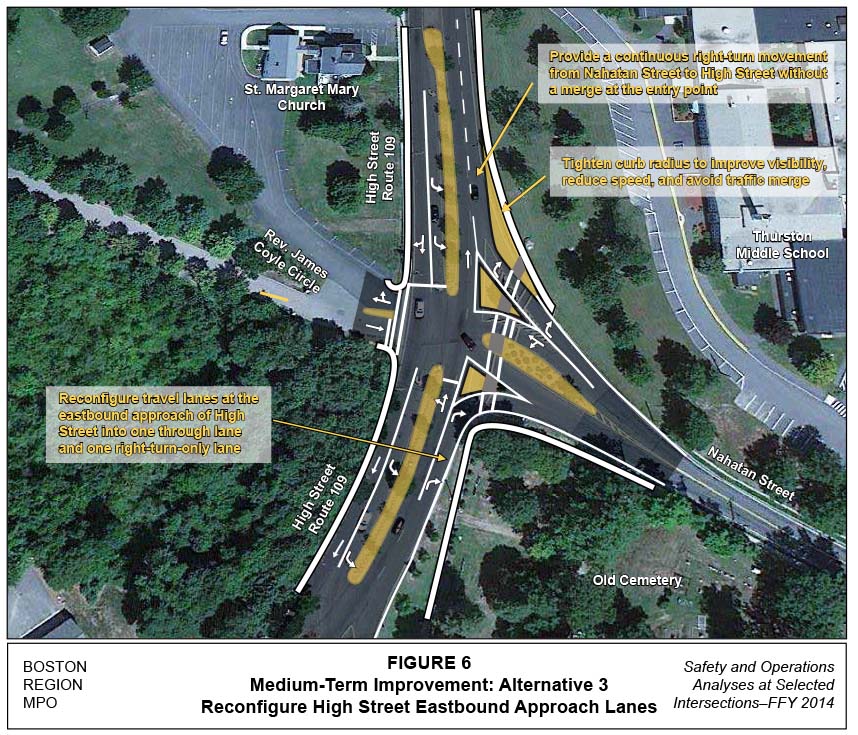
This lane reconfiguration would reduce crashes by approximately 22 percent.11 Further, providing full sight distance where it currently does not occur would reduce related crashes by approximately 20-to-37 percent.12 It would cost between $30,000 and $50,000 to implement these modifications, including curbing, restriping, and signing.
Alternative 4 is a variation of Alternative 3; it excludes reconfiguring High Street’s eastbound approach lanes (Figure 7). Alternative 4 would tighten the Nahatan Street approach curb line radius in order to allow right-turn movement to approach High Street more perpendicularly, which would improve sight lines and distances and reduce speeds. In addition, it would add a stop-sign control for that movement. As in Alternative 3, the angle of the right-turn channelized lane should be no less than 70 degrees. This strategy is more costly than replacing a yield sign with a stop sign only (Alternative 1), but it is a more effective strategy for reducing crashes at a location with poor sight distance and a persistent crash pattern that cannot be improved with less expensive methods.
As in Alternative 3, providing full sight distance where it currently does not occur would reduce related crashes by approximately 20-to-37 percent.13 Table 6 (above) shows the results of the 2024 future year LOS analysis—Alternative 4 would not reduce traffic delays for Nahatan Street left-turn movement. It would cost between $30,000 and $50,000 to construct these improvements.
Installing a new traffic signal at the intersection would provide right-of-way assignment for traffic on Nahatan Street to enter High Street, reducing the large number of angle and rear-end crashes (Figure 8). Traffic signal warrant analysis shows that the intersection meets five of the nine warrants and justifies installing a traffic signal control (see Section 6). At present, the conduits, wiring, and interconnections for the traffic signal have been installed. In addition to the signalization, MPO staff recommends tightening the Nahatan Street approach curb-line radius in order to allow the right-turn movement to approach High Street more perpendicularly.
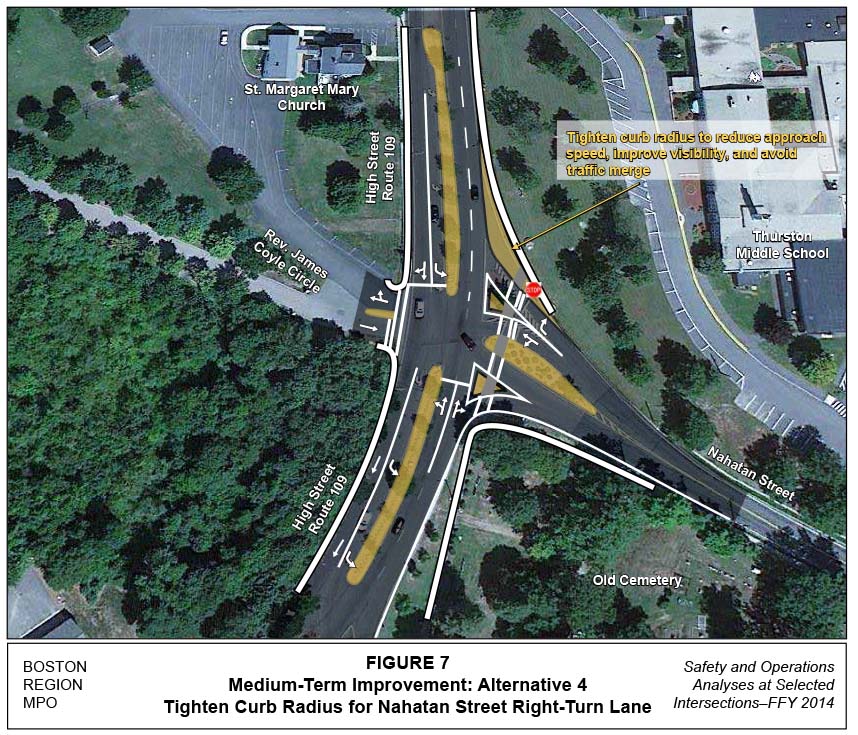
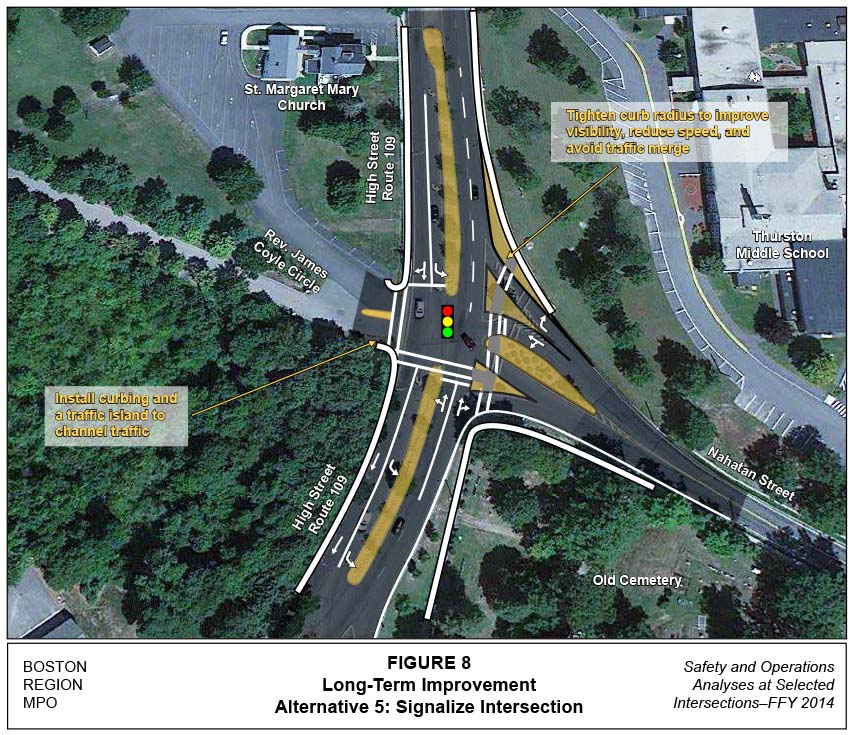
Converting a two-way stop-sign control to a traffic-signal control could result in a 28-to-56 percent reduction in crashes.14 Table 6 shows the results of the 2024 future year LOS analysis, which indicate that a traffic signal would improve overall traffic operations and reduce delays and queues at the intersection. Installing a traffic signal at the intersection would cost approximately $1.5 million.
The design features of modern roundabouts encourage slower speeds, so are proven strategies for reducing severe-injury crashes. In addition, the yield-on-entry rule and one-way circulating flow of roundabouts reduce the number of conflict points and cut down on angle crashes significantly. Because of the safety and operational benefits of modern roundabouts, their appeal has risen throughout the Commonwealth in the past decade.15
Figure 9 shows the roundabout alternative and how it streamlines traffic circulation. The roundabout proposal includes the following features:
Converting a two-way stop control to a roundabout could reduce crashes by approximately 44-to-77 percent.16 Staff used Sidra intersection roundabout analysis software to analyze the roundabout alternative.17 Table 6 (above) shows the results of the 2024 future year analysis, which indicates that a roundabout would improve overall traffic operations and reduce delays and queues. Converting the intersection to a roundabout would cost approximately $1.5-to-$2.0 million.
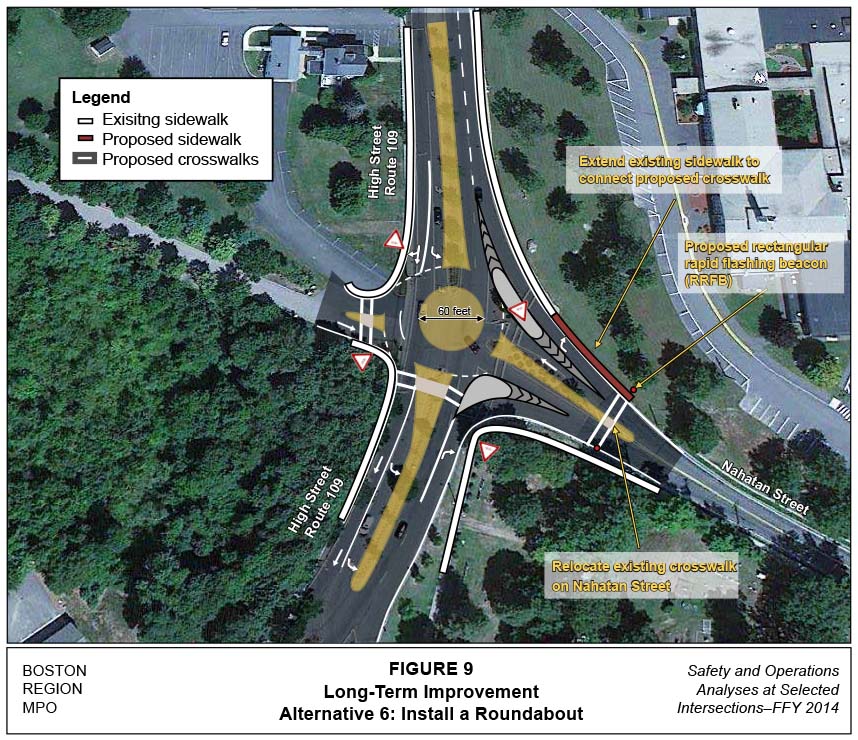
In order for a roundabout to function well, it is important to prevent traffic queues from spreading into it, causing gridlock. The recurring traffic queue eastbound on High Street, which currently extends from the Hartford Avenue intersection into the Nahatan Street intersection, would prevent a roundabout from functioning well during peak periods.
The concerns at the intersections are:
MPO staff developed and analyzed three short- and long-term alternatives for addressing safety and traffic operations at the intersection.
Pond Street
Next Intersection
D3-2
Advance street name sign
Pond Street
W16-8P
Advance street name plaque
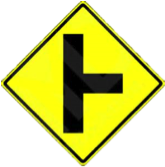
W2-2
Intersection warning sign
Source: MUTCD 2009 edition
Improved driver awareness and sight distance—as viewed from the Pond Street approach—such as flashing light-emitting diode (LED) stop signs and clearing some of the vegetation would reduce the number of right angle crashes. Increasing the triangle sight distance would reduce property-damage-only crashes by as much as 11 percent.18

Source: safety.fhwa.dot.gov
This alternative would increase safety by:
The proposed improvement, shown in Figure 10, would reduce vehicle-pedestrian conflicts, which are a significant problem in the channelized right-turn lane, receiving many complaints from neighborhood residents. Supplementary signing on High Street (recommended in Alternative 1) to increase driver awareness would enhance this improvement’s effectiveness. The 2024 future LOS analysis shows that the improvements would not affect the capacity of the right-turn movement (Table 7). Tightening the curb line radius and improving signage at the intersection would cost approximately $30,000.
Installing a new traffic signal—“walk-and-don’t-walk” times for pedestrians and “green times” for traffic on High Street and Pond Street—would increase safety and reduce peak-period traffic delays. Traffic signal warrant analysis shows that the intersection meets three of the nine warrants and justifies installing a traffic signal control (see Section 6). Figure 11 shows the intersection layout for the proposed traffic signal, including tightening the curb line radius for High Street eastbound right-turn movements. Additional improvements include providing a crosswalk across High Street and pedestrian signals with pushbuttons and countdown timers.
Table 7 presents results of the 2024 future year LOS analysis, which indicate that installing a traffic signal would improve overall traffic operations. Converting a two-way stop control to a traffic signal would reduce total crashes by about 28-to-56 percent.19 These improvements would cost approximately $1.5 million.
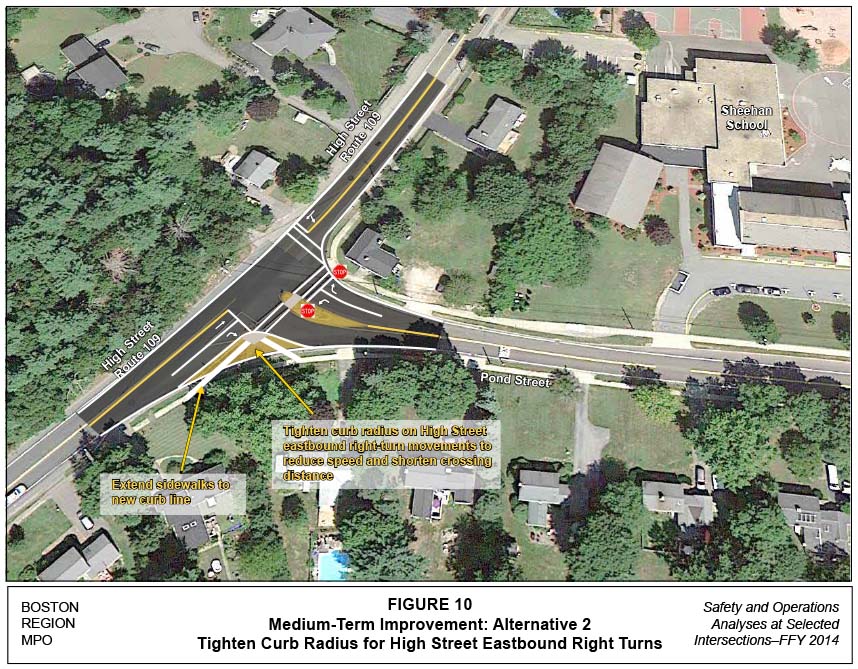
TABLE 7
High Street and Pond Street Intersection (Near Sheehan School)
Future Year (2024) Peak-Hour Level of Service
Intersection/Approach |
Move |
AM LOS |
AM Delaya |
AM Queueb |
PM LOS |
PM Delay |
PM LOS |
2014 Existing Conditions |
-- |
-- |
-- |
-- |
-- |
-- |
-- |
High St Eastbound |
T+R |
A |
0 |
0 |
A |
0 |
0 |
High St Westbound |
L+T |
A |
0 |
0 |
A |
0 |
0 |
Pond St Northbound |
L |
F |
114.5 |
225 |
F |
152.9 |
350 |
Pond St Northbound |
T+R |
B |
14.4 |
25 |
A |
9.8 |
5 |
Total Intersection |
All |
C |
17.8 |
-- |
D |
28.6 |
-- |
2024 Alternative 2: Reduce Curb Line |
-- |
-- |
-- |
-- |
-- |
-- |
-- |
High St Eastbound |
T+R |
A |
0 |
0 |
A |
0 |
0 |
High St Westbound |
L+T |
A |
0.1 |
0 |
A |
8.5 |
25 |
Pond St Northbound |
L |
F |
149.7 |
275 |
F |
>180 |
425 |
Pond St Northbound |
T+R |
B |
14.8 |
10 |
A |
9.9 |
25 |
Total Intersection |
All |
C |
23.5 |
-- |
D |
34.8 |
-- |
2024 Alternative 3: Install Traffic Signal |
-- |
-- |
-- |
-- |
-- |
-- |
-- |
High St Eastbound |
T |
B |
18 |
#590 |
B |
14.2 |
305 |
High St Eastbound |
R |
A |
6.1 |
145 |
A |
4.6 |
63 |
High St Westbound |
L |
B |
11.2 |
26 |
A |
12.1 |
42 |
High St Westbound |
T |
A |
9.8 |
198 |
C |
26.1 |
#750 |
Pond St Northbound |
L |
D |
42.6 |
#290 |
D |
48.5 |
#365 |
Pond St Northbound |
R |
A |
0.1 |
13 |
A |
8.8 |
31 |
Total Intersection |
All |
B |
16.2 |
-- |
C |
23.6 |
-- |
a Delay in seconds per vehicle. b 95th percentile queue length in feet. # = The 95th percentile volume exceeds capacity.
Source: Central Transportation Planning Staff.
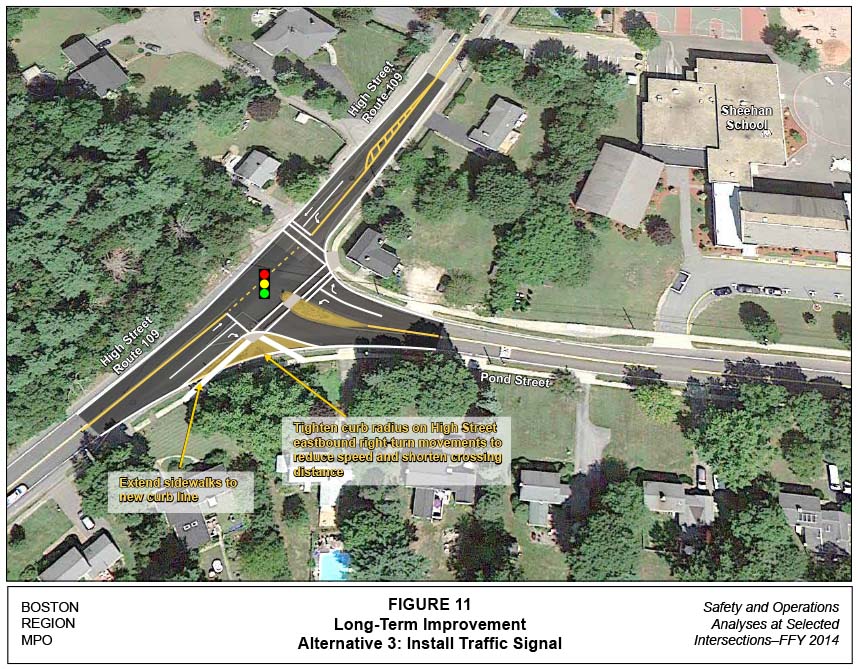
The above evaluations indicate that the intersections of High at Nahatan Streets and Pond Street need improvements to increase safety and reduce congestion. MPO staff has developed six alternatives to improve safety and traffic operations at the Nahatan Street intersection, and three alternatives to improve safety at the Pond Street intersection. Cost and effectiveness are primary factors in selecting the preferred alternatives.
MPO staff recommends Alternative 3 for short- and medium-term improvements. These modifications would improve safety by increasing sight lines and distances; reduce speeds of vehicles turning right onto High Street, and make traffic operations more efficient by reducing merging maneuvers.
For long-term improvements, MPO staff recommend Alternative 5, which would provide all of the safety benefits of Alternative 3. In addition, Alternative 5 would provide orderly movement of traffic (vehicular and pedestrian) and reduce the frequency and severity of crashes. Alternative 5 also would reduce traffic congestion, but Alternative 3 would not. The conduits, wiring, and interconnections required for installing a traffic signal already have been installed, which would facilitate implementation.
This study gives the Town of Westwood an opportunity look at the needs of these intersections and plan for design and engineering. Following this planning study, the next steps are to implement the preferred low-cost, short-term improvements. Implementation of the long-term, high-cost improvements hinge upon cooperation between MassDOT, Westwood, and the MPO to begin the project notification and review process, complete a project initiation form, and initiate the preliminary design and engineering necessary to place the project on the Transportation Improvement Program (TIP). Appendix E contains MassDOT project development process for highway projects. Finally, the study supports the MPO’s visions and goals, which include increasing transportation safety, preserving and maintaining the transportation system, and advancing mobility, access and congestion reduction.
SA/sa
Cc: Michael Jaillet, Town Administrator, Westwood
1 Appendix A includes a letter from Michael Jaillet, Town Administrator, Westwood to Karl Quackenbush, Executive Director, CTPS, dated November 12, 2013, which supports a study at the two intersections. This appendix also contains a list of task force members, and comments from Westwood and MassDOT—which have been addressed and incorporated in this memorandum.
2 Seth Asante, memorandum to Boston Region MPO, Safety and Operations Analyses at Selected Intersections—FFY 2013, Task 1: Intersection Selection Procedure, December 19, 2013.
3 Transit Significance: Location carries bus route(s) or is adjacent to a transit stop or station.
4 Regional Significance: Location carries high proportion of regional traffic or noticeable commuter bicycle traffic.
5 Implementation Potential: Location either is under MassDOT jurisdiction, has a Transportation Improvement Process (TIP) “conceptual” status, or has a strong commitment from a city or town.
6 Highway Capacity Manual 2010, Transportation Research Board of the National Academies, Washington, DC, December 2010.
7 Trafficware Inc., Synchro Studio 8, Synchro plus SimTraffic, Build 801, Version 563, Sugar Land, Texas.
8 US Department of Transportation, Federal Highway Administration, Manual on Uniform Traffic Control Devices for State Streets and Highways, 2009 Edition.
9 Crash Modification Factors Clearinghouse, US Department of Transportation Federal Highway Administration.
10 Sherbutt, J., R. Van Houten, and S. Turner. "An Analysis of the Effects of Stutter Flash LED Beacons to Increase Yielding to Pedestrians Using Multilane Crosswalks." Presented at the Transportation Research Board Annual Meeting, Washington, DC, 2008.
11 Crash Modification Factors Clearinghouse, US Department of Transportation Federal Highway Administration, website, http://www.cmfclearinghouse.org/, December 17, 2014.
12 Ibid.
13 Ibid
14 Crash Modification Factors Clearinghouse, US Department of Transportation Federal Highway Administration, website, http://www.cmfclearinghouse.org/, December 17, 2014
15 In this document, the word roundabout refers to modern roundabouts that have a smaller central island and tighter deflection angle to slow down vehicles entering the roundabout and in the circulatory lane(s) to speeds between 20 and 25 mph.
16 Crash Modification Factors Clearinghouse, US Department of Transportation Federal Highway Administration.
17 Sidra Intersection 6, Akcelik and Associates Pty Limited, Greythorn, Victoria, Australia.